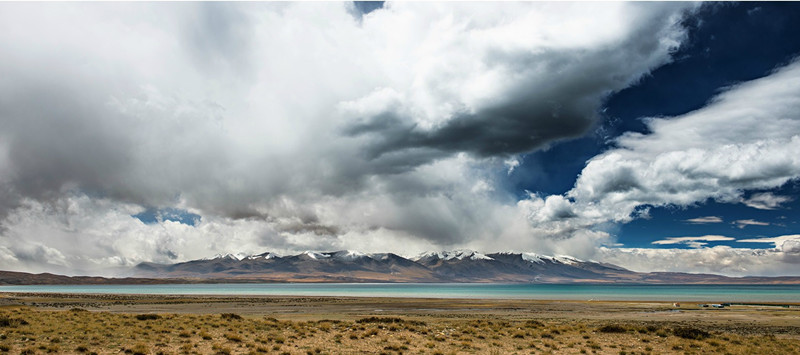
Lake Manasarovar, Ngari
Chinese Name: 玛旁雍措
English Name: Lake Manasarovar in Burang County, Ngari
Location: Located in Burang County, Ngari, Tibet Autonomous Region
Admission Fee: Free
Opening Hours: All Day
About Lake Manasarovar
Covering more than 400 square kilometers of waters, Lake Manasarovar is the world’s highest freshwater lake which is revered a sacred place in four religions: Bön, Buddhism, Hinduism and Jainism with an altitude of 4,587 meters above sea level and the water depth of 77 meters. It is the holiest lake in Asia and an important pilgrimage destination for Hindus and Buddhists alike. Pilgrims come to take ceremonial baths in the cleansing waters of the lake. To the west of it is Lake Rakshastal; to the north is Mount Kailash. The word “Manasarovar” originates from Sanskrit language, which is a combination of the words “Manas” “Sarovara” manas meaning mind and sarovar meaning lake.In the Buddhist scriptures, only a lake is called “mother of the World Rivers”, and that refers to Lake Manasarovar. It means is “invincible lake” in the Tibetan words.
According to legend, Lake Manasarovar is the lake in which a great Tibetan monk saw the letters “Aha”, ” Kha”, ” Mha”. These three initials helped the search team to locate the current the 14th Dalai Lama of Tibet. The three initials stand for the province, the district, and the monastery in which the current Dalai Lama was born, i.e. Ahamdho, Khunbum, and Taktser respectively.
History of Lake Manasarovar
There were eight Buddhist monasteries around the lake, symbolizing the Wheel of Life. Pilgrims used to circumambulate the lake, visiting each of the monasteries along the way, representing a turn of the wheel. Most of the monasteries have now disappeared (the most notable survivor being Chiu Gompa), but Buddhists still make the pilgrimage around the sacred lake.
Myth and Mystery
According to Hindu tradition, Manasarovar was created by Brahma, god of creation, to provide an appropriate place for religious rituals. It is said that he had 12 sons, who were holy men and performed rituals and austerities on the dry land at the site. To give them a more suitable place to earn merit, Brahma created the beautiful Lake Mansarovar.
The lake’s Indian name derives from this legend: Brahma had a mind (manas) to create a lake (sarowar). For Hindus, a circumambulation of Mount Kailash and a dip in the cold waters of Lake Mansarowar removes the sins of all lifetimes, bringing salvation from reincarnation.
Buddhists associate Manasarovar with Anotatta Lake, where the Buddha was mystically conceived. According to Buddhist legend, the Buddha’s mother was transported here by the gods, where she bathed in the sacred waters of Manasarovar until her body was purified. She then saw a white elephant running to her from Mount Kailash, as the Buddha entered her womb.
What to Visit in Lake Manasarovar
Located at the southern base of Mount Kailash, Lake Manasarovar is famed for its exceptional beauty. Its color changes from a clear blue around the shores to a deep emerald green in the center; it looks positively magical in the moonlight. The lake is 55 miles (88 km) in circumference, 330 feet (90m) deep, and 120 sq mi (320 sq km) in total area.
The journey around the lake is 64 miles long and usually takes four days. Many travelers opt to pitch a tent by the lake for a couple days instead, recuperating from the strenuous journey around Mount Kailash.
Tourist Services of Lake Manasarovar
Cuisine and Snack: In Burang County, there are many delicacy snacks.
Accommodation: After you enjoy the gorgeous scenery of Lake Manasarovar, you may accommodate in the hotels if you can’t get back to Burang County in time.
Shopping: Burang was rich in natural forest resources, including economic plants and medicinal plants. As for the economic plants, there are many wild plantain and bananas
Attraction Transportation:
Burang County Transportation
You can choose either self-driving traveling or take public transportation. According to your beginning place, there may be different ways to go to Burang County. There are two main lines available below.
• Lhasa- Ngari- Burang County
You can reach Lhasa by air or train. Then take a bus to Burang County.
• Ngari- Burang County
You can also take a specific train to Ngari and take a bus to Burang County.
Attraction Travel Tips:
- Traveling Hours: 1 day
- Traveling Seasons: June and July
- High Altitude Sickness Avoiding: Bring enough water or drinks, fruits and snacks with high caloric content.
- Pay attention to prepare some cold weather gear like a hat, gloves, a scarf and a thick winter coat.
- The Border Permit is required to enter the mountain; as it is less convenient to apply for one in Tibet, it is suggested to obtain the permit ahead of the travelling.

















